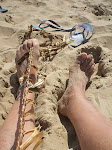I could not have a nicer neighbour than Anne-Marie who loves her garden and is a very knowledgeable gardener. To her the garden is an extension of her pristine home that needs just as much housekeeping. Consequently she views overgrown lawns, weeds and the leaves that gently tumble from the trees at this time of year as a visible sign that she is failing as a housekeeper.
The lawn is dealt with in agri business fashion (as befits a farmers wife) with a sit on mower that sounds like a small tractor. When I hear its pistons cranking up and the blades reaching take off speed I know that rain is forecast within 24 hours. But, the weeds on the gravel and the leaves on the roads leading to her house need constant scratching and scraping and sweeping. Usually she uses a plastic leaf rake which has a distinctly plastic sound but yesterday I was surprised to hear a new type of swishing noise coming from the road and of course I had to investigate. My reward was to see Anne-Marie sweeping like a demon with a very obviously home-made besom, it doesn't take much to make me happy but this humble object gave me unadulterated joy! Apparently the plastic rake had broken.
Anne Marie doesn't know what particular plant she used but, traditionally in colder temperate climes besoms are made of birch or heather because they have the right amount of fine but resilient branches for the job. In Nova Scotia according to Peter Barrs and Joleen Gordon in "Older Ways Traditional Nova Scotian Craftsmen" (ISBN0-442-29628-2) there used to be a tradition of 'sheen brooms' made from a single pole of yellow birch where, instead of the branches being used as the brush head, the wood is peeled away in layers or 'sheens' to create the brush fibres, leaving the unpeeled part as the handle.
 Technically speaking the 'Anne Marie special' is more correctly a 'swale' as it does not have a separate handle, this I discovered in the excellent " Encyclopedia of Green Wood Working" by Ray Tabor (ISBN 1-899233-07-5)
Technically speaking the 'Anne Marie special' is more correctly a 'swale' as it does not have a separate handle, this I discovered in the excellent " Encyclopedia of Green Wood Working" by Ray Tabor (ISBN 1-899233-07-5)Of course, there are plenty of home made simple plant fibre brooms besoms and swales still being made and used all over the world but, it is rare now in northern Europe to find a person under retirement age who would think of making one for themselves, rather than spend their hard earned money buying something that will inevitably make someone higher up the food chain rich on the profit.
 A plastic leaf rake costs about 20€ in my local 'garden centre'. Manufactured in China from planet munching materials it has probably been shipped to Europe on an ocean going skyscraper of metal boxes and I would need to work for at least an hour and a half (on the average French take home pay) to earn enough to buy one. Anne Marie thinks her swale does a superb job and it only took her about 15 minutes to cut the twigs from her hedgerow and bundle them with used baler twine which leaves her with a plus balance of 1 hour 15 minutes in her life account with which she can go and do something she really enjoys - which in her case is ironing!
A plastic leaf rake costs about 20€ in my local 'garden centre'. Manufactured in China from planet munching materials it has probably been shipped to Europe on an ocean going skyscraper of metal boxes and I would need to work for at least an hour and a half (on the average French take home pay) to earn enough to buy one. Anne Marie thinks her swale does a superb job and it only took her about 15 minutes to cut the twigs from her hedgerow and bundle them with used baler twine which leaves her with a plus balance of 1 hour 15 minutes in her life account with which she can go and do something she really enjoys - which in her case is ironing!




No comments:
Post a Comment